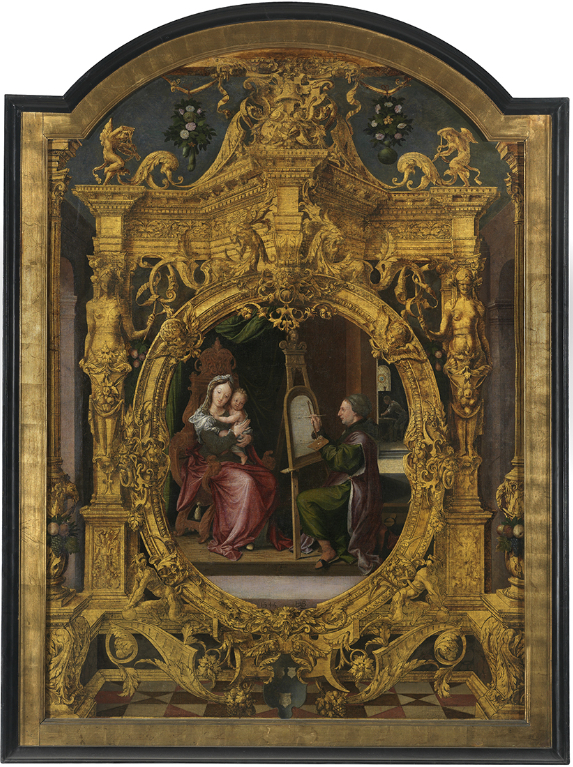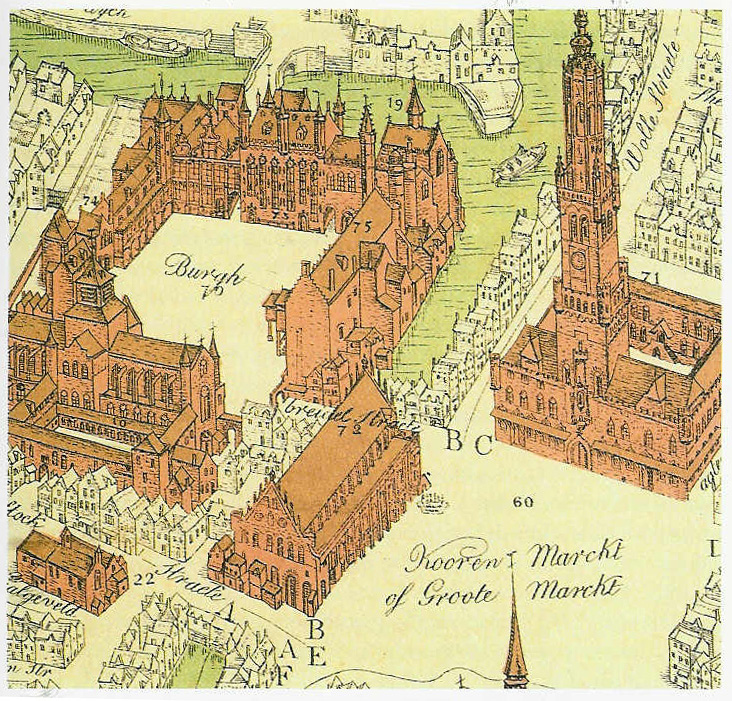|
Brugse Vrije
The Brugse Vrije was a castellany in the county of Flanders, often called in English "the Franc of Bruges". It included the area around Bruges, and was bordered by the North Sea, the Westerschelde and the Yser river. The city of Bruges was separated from the castellany in 1127. Since then the city and the Vrije were considered as separate customary law areas. The Brugse Vrije was a rich agricultural region. It had its own burgrave, who was seated at the Burg, a square in Bruges, and became part of the Four Members of Flanders at the end of the 14th century, together with the three major cities of Ghent, Bruges and Ypres. The Brugse Vrije sat in the meetings of the States of Flanders. Organisation The castellany of Bruges was founded at around the year 1000 under the rule of Count Baldwin IV of Flanders (980–1035) as part of the county of Flanders. The head of the castellany was a burgrave, who represented the Count of Flanders. The burgrave was replaced by a bailiff in ... [...More Info...] [...Related Items...] OR: [Wikipedia] [Google] [Baidu] |
Burgrave
Burgrave, also rendered as burggrave (from german: Burggraf, la, burgravius, burggravius, burcgravius, burgicomes, also praefectus), was since the medieval period in Europe (mainly Germany) the official title for the ruler of a castle, especially a royal or episcopal castle, and its territory called a ''Burgraviate'' or ''Burgravate'' (German ''Burggrafschaft'' also ''Burggrafthum'', Latin ''praefectura'').Encyclopædia Britannica; Definition of ''burgrave (title)''/ref>Duden; Definition of ''Burggraf'' (in German)/ref> The burgrave was a "count" in rank (German ''Graf'', Latin ''comes'') equipped with judicial powers, under the direct authority of the emperor or king, or of a territorial imperial state—a prince-bishop or territorial lord. The responsibilities were administrative, military and jurisdictional. A burgrave, who ruled over a substantially large territory, might also have possessed the regality of coinage, and could mint his own regional coins (see silver brac ... [...More Info...] [...Related Items...] OR: [Wikipedia] [Google] [Baidu] |
History Of Flanders
This article describes the history of Flanders. The definition of the territory called "Flanders" ( nl, Vlaanderen), however, has varied throughout history. The historical county of Flanders is now split into different countries. It roughly encompassed Zeelandic Flanders in the Netherlands, French Flanders in France, and the Belgian provinces of West Flanders, East Flanders as well as part of Hainaut. The city of Ghent was the capital. Today, "Flanders" is a term referring to the Flemish Region, which is defined as the Dutch-speaking part of the Kingdom of Belgium. It contains within it the core of the old county, West Flanders and East Flanders, plus three more culturally-related provinces to the east which were not originally part of Flanders. These are the provinces of Antwerp and Flemish Brabant which were historically part of the Duchy of Brabant, and the province of Belgian Limburg, which was part of the Prince-Bishopric of Liège. The city of Brussels, historically part o ... [...More Info...] [...Related Items...] OR: [Wikipedia] [Google] [Baidu] |
County Of Flanders
The County of Flanders was a historic territory in the Low Countries. From 862 onwards, the counts of Flanders were among the original twelve peers of the Kingdom of France. For centuries, their estates around the cities of Ghent, Bruges and Ypres formed one of the most affluent regions in Europe. Up to 1477, the area under French suzerainty was west of the Scheldt and was called "Royal Flanders" (Dutch: ''Kroon-Vlaanderen'', French: ''Flandre royale''). Aside from this, the counts, from the 11th century onward, held land east of the river as a fief of the Holy Roman Empire: "Imperial Flanders" (''Rijks-Vlaanderen'' or ''Flandre impériale''). Part of the Burgundian Netherlands from 1384, which had a complex relation with France, the whole county fell to the Empire after the Peace of Madrid in 1526 and the Peace of the Ladies in 1529. Having already regained much, by 1795, the rest – within the Austrian Netherlands – was acquired likewise by France under the Frenc ... [...More Info...] [...Related Items...] OR: [Wikipedia] [Google] [Baidu] |
Jan Baptist Van Meunincxhove
Jan Baptist van Meunincxhove (c. 1620/25 – 1703/04) was a Flemish painter of cityscapes, architectural paintings, marine views and group portraits who was active in Bruges. Without being original, he maintained a high standard of painting at a time when art in Flanders was in decline. Life Details about the life of Jan Baptist van Meunincxhove are few. He was born around 1620-25 and became in 1639 a pupil of the leading artist Jacob van Oost in Bruges. Van Meunincxhove became a master in the Bruges Guild of Saint Luke in 1644.Jan Baptist van Meunincxhove at the He is recorded in Antwerp in 1677 when he became a master in ... [...More Info...] [...Related Items...] OR: [Wikipedia] [Google] [Baidu] |
Lanceloot Blondeel
Lancelot Blondeel, also Lanceloot (1498 – 4 March 1561), was a Flemish painter, designer of sculptures, tapestries and jewelry, architect, city planner, surveyor and cartographer who was active in Bruges.Lancelot Blondeel at the E. De Jongh, ''Lanceloot Bondeel, Sint-Lucas die Madonna schildert'' in: Openbaar Kunstbezit Vlaanderen, 1977 – 10de jaa ... [...More Info...] [...Related Items...] OR: [Wikipedia] [Google] [Baidu] |
Courthouse
A courthouse or court house is a building that is home to a local court of law and often the regional county government as well, although this is not the case in some larger cities. The term is common in North America. In most other English-speaking countries, buildings which house courts of law are simply called "courts" or "court buildings". In most of continental Europe and former non-English-speaking European colonies, the equivalent term is a palace of justice ( French: ''palais de justice'', Italian: ''palazzo di giustizia'', Portuguese: ''palácio da justiça''). United States In most counties in the United States, the local trial courts conduct their business in a centrally located courthouse. The courthouse may also house other county government offices, or the courthouse may consist of a designated part of a wider county government building or complex. The courthouse is usually located in the county seat, although large metropolitan counties may have satellite or ... [...More Info...] [...Related Items...] OR: [Wikipedia] [Google] [Baidu] |
Jan Verkruys
Jan, JaN or JAN may refer to: Acronyms * Jackson, Mississippi (Amtrak station), US, Amtrak station code JAN * Jackson-Evers International Airport, Mississippi, US, IATA code * Jabhat al-Nusra (JaN), a Syrian militant group * Japanese Article Number, a barcode standard compatible with EAN * Japanese Accepted Name, a Japanese nonproprietary drug name * Job Accommodation Network, US, for people with disabilities * ''Joint Army-Navy'', US standards for electronic color codes, etc. * ''Journal of Advanced Nursing'' Personal name * Jan (name), male variant of ''John'', female shortened form of ''Janet'' and ''Janice'' * Jan (Persian name), Persian word meaning 'life', 'soul', 'dear'; also used as a name * Ran (surname), romanized from Mandarin as Jan in Wade–Giles * Ján, Slovak name Other uses * January, as an abbreviation for the first month of the year in the Gregorian calendar * Jan (cards), a term in some card games when a player loses without taking any tricks or scoring a mini ... [...More Info...] [...Related Items...] OR: [Wikipedia] [Google] [Baidu] |
Neoclassical Architecture
Neoclassical architecture is an architectural style produced by the Neoclassical movement that began in the mid-18th century in Italy and France. It became one of the most prominent architectural styles in the Western world. The prevailing styles of architecture in most of Europe for the previous two centuries, Renaissance architecture and Baroque architecture, already represented partial revivals of the Classical architecture of ancient Rome and (much less) ancient Greek architecture, but the Neoclassical movement aimed to strip away the excesses of Late Baroque and return to a purer and more authentic classical style, adapted to modern purposes. The development of archaeology and published accurate records of surviving classical buildings was crucial in the emergence of Neoclassical architecture. In many countries, there was an initial wave essentially drawing on Roman architecture, followed, from about the start of the 19th century, by a second wave of Greek Revival architec ... [...More Info...] [...Related Items...] OR: [Wikipedia] [Google] [Baidu] |
Jan Van De Poele
Jan, JaN or JAN may refer to: Acronyms * Jackson, Mississippi (Amtrak station), US, Amtrak station code JAN * Jackson-Evers International Airport, Mississippi, US, IATA code * Jabhat al-Nusra (JaN), a Syrian militant group * Japanese Article Number, a barcode standard compatible with EAN * Japanese Accepted Name, a Japanese nonproprietary drug name * Job Accommodation Network, US, for people with disabilities * ''Joint Army-Navy'', US standards for electronic color codes, etc. * ''Journal of Advanced Nursing'' Personal name * Jan (name), male variant of ''John'', female shortened form of ''Janet'' and ''Janice'' * Jan (Persian name), Persian word meaning 'life', 'soul', 'dear'; also used as a name * Ran (surname), romanized from Mandarin as Jan in Wade–Giles * Ján, Slovak name Other uses * January, as an abbreviation for the first month of the year in the Gregorian calendar * Jan (cards), a term in some card games when a player loses without taking any tricks or scoring a mini ... [...More Info...] [...Related Items...] OR: [Wikipedia] [Google] [Baidu] |
Dukes Of Burgundy
Duke of Burgundy (french: duc de Bourgogne) was a title used by the rulers of the Duchy of Burgundy, from its establishment in 843 to its annexation by France in 1477, and later by Holy Roman Emperors and Kings of Spain from the House of Habsburg who claimed Burgundy proper and ruled the Burgundian inheritance in the Low Countries. The Duchy of Burgundy was a small portion of the traditional lands of the Burgundians west of the river Saône which, in 843, was allotted to Charles the Bald's kingdom of West Franks. Under the Ancien Régime, the Duke of Burgundy was the premier lay peer of the kingdom of France. Beginning with Robert II of France, the title was held by the Capetians, the French royal family. It was granted to Robert's younger son, Robert, who founded the House of Burgundy. When the senior line of the House of Burgundy became extinct, it was inherited by John II of France through proximity of blood. John granted the duchy to his younger son, Philip the Bold. The Va ... [...More Info...] [...Related Items...] OR: [Wikipedia] [Google] [Baidu] |
Het Steen (Bruges)
Het Steen was a medieval building on the Burg Square in Bruges, Belgium. Between the late 11th and late 13th centuries, it served as the residence of the Counts of Flanders.Brigitte Beernaert, 'Het Steen. Een benadering van de vroegere Brugse gevangenis', in ''Van middeleeuwen tot heden. Bladeren door Brugse kunst en geschiedenis'', Brugge, 1983. History It is not clear whether the building was a successor to the ''Oude Steen'', which is on ''Wollestraat'' – in the oldest part of the city – and which has cornerstones dating back to the 11th or 12th century. Steen Castle may also date from that period, but little is known about its early history. It is likely that it was built to replace a wooden structure. According to historians, the first stone building - a keep - was built between 863 and 965 by Count Baldwin I, Count Baldwin II or Count Arnulf I. Another historian has dated the building to the reign of Count Baldwin V (1035 – 1067). The first definite date that c ... [...More Info...] [...Related Items...] OR: [Wikipedia] [Google] [Baidu] |


.png)



_-_facade_on_Piazza_dei_signori.jpg)
